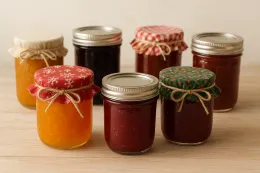
by Sherida Phibbs, UCCE Master Food Preserver
Ever wonder why one jar is called jelly and another jam? Or what on earth a conserve really is? You’re not alone! While all these spreads are sweet, fruity, and delicious, each has its own personality. Here’s a friendly guide to help you tell them apart—and some insider tips for making them at home.
Jelly
Think of jelly as the “gemstone” of fruit spreads—it’s made from strained fruit juice, sugar, and pectin, so it’s crystal clear and firm enough to hold its shape. A good jelly sparkles, quivers when you shake the jar, and cuts cleanly without oozing. It should taste fresh and fruity—not too sweet, not too tart.
Fun fact: Some jellies are made without cooking using special no-cook recipes.
Jam
Jam is jelly’s more relaxed cousin. It’s made from chopped or crushed fruit, cooked with sugar until it becomes thick and spreadable. The fruit breaks down during cooking, so you get a soft, spoonable spread that’s bursting with flavor.
Preserves
If you like a rustic feel, preserves are for you! They feature whole or chunky pieces of fruit suspended in syrup. The fruit should be tender, plump, and colorful—not mushy. Spoon them over biscuits or swirl into yogurt for a treat.
Conserves
Conserves take preserves up a notch by mixing fruits together—sometimes with nuts, raisins, or even coconut. They’re soft, spreadable, and a little fancy. Pair a fig conserve with goat cheese, and you’ll never look back!
Marmalade
Ah, marmalade—the bright burst of citrus sunshine. Made from citrus juice and peel, marmalade balances sweet with just a hint of bitterness. Orange marmalade is the classic, but lemon or grapefruit marmalades are equally delightful.
Fruit Butters
No butter here—just pure fruit goodness. Fruit butters are made by cooking fruit pulp slowly with sugar (and often spices) until thick and smooth. Apple butter is a fall favorite, but pear is a wonder choice too.
The Secret Science
Here’s what makes spreads work:
- Fruit = flavor, color, and sometimes natural pectin and acid
- Pectin = the magic gelling agent (added when fruit doesn’t have enough)
- Acid = helps the gel set and brightens the flavor
- Sugar = sweetener, preservative, and partner in the gelling process
Tip: Use ¼ slightly underripe fruit + ¾ fully ripe fruit for best results.
Quick Reminders for Success
- Always use tested recipes (no cutting back on sugar unless using special low-sugar pectin).
- Artificial sweeteners don’t work in traditional recipes.
- Store commercial pectin in a cool, dry place and use before its expiration date.
- Always finish with safe canning methods—boiling water bath or atmospheric steam processing keeps jars shelf-stable.
Bottom Line
Whether you like the sparkle of jelly, the chunkiness of preserves, or the velvety richness of fruit butter, there’s a fruit spread to match every mood. So grab some fruit, sugar, and jars, and spread the joy year-round!
Fruit spreads guidelines and recipes:
